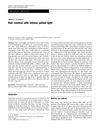signaling protein that, when suppressed, may grow hair by reducing inflammation and stem cell loss
glycoprotein that inhibits TGF-β and promotes hair growth by antagonizing activin
mitochondrial pyruvate carrier (MPC) inhibitor by Pelage in early trials
chemical from L'Oreal that encourages hair to enter growth phase
a signaling molecule from dermal papilla cells being actively researched



